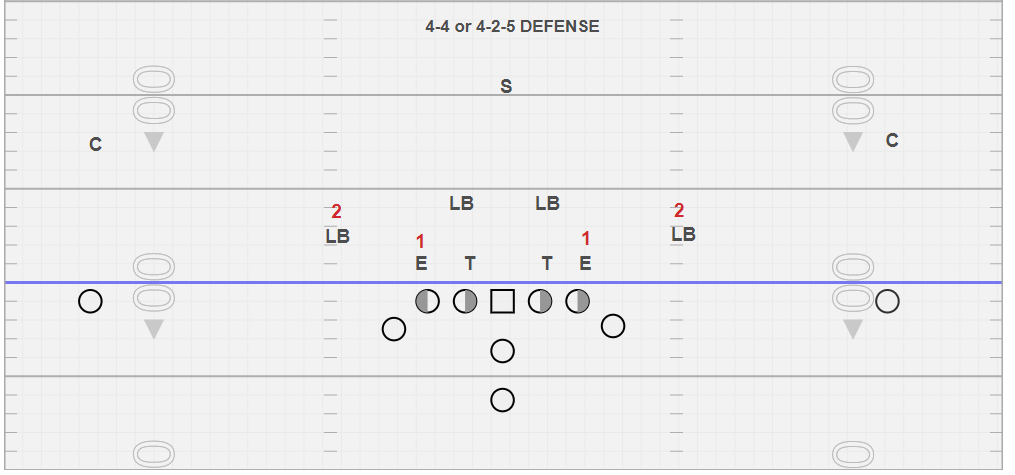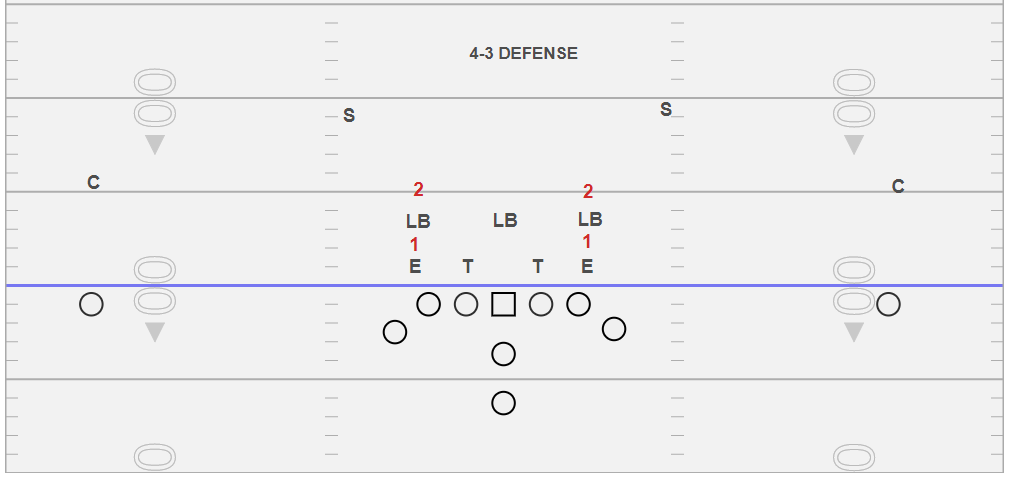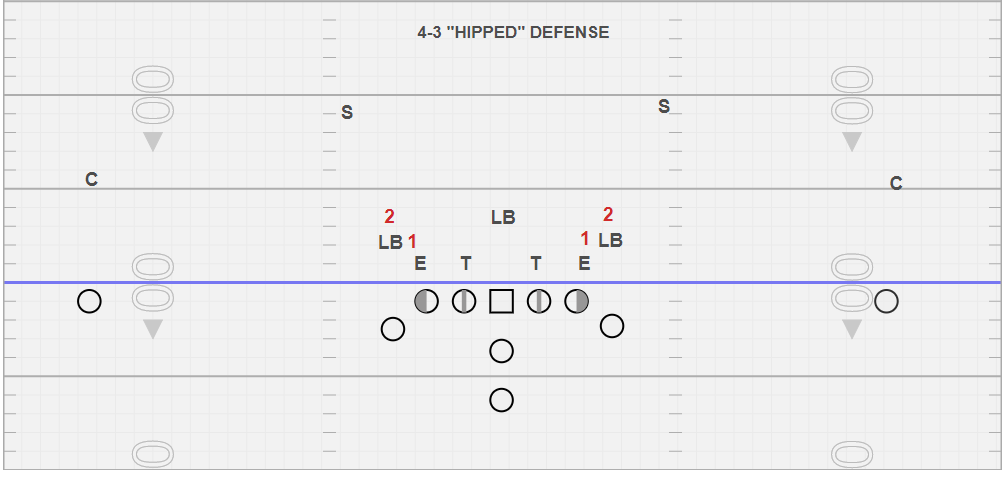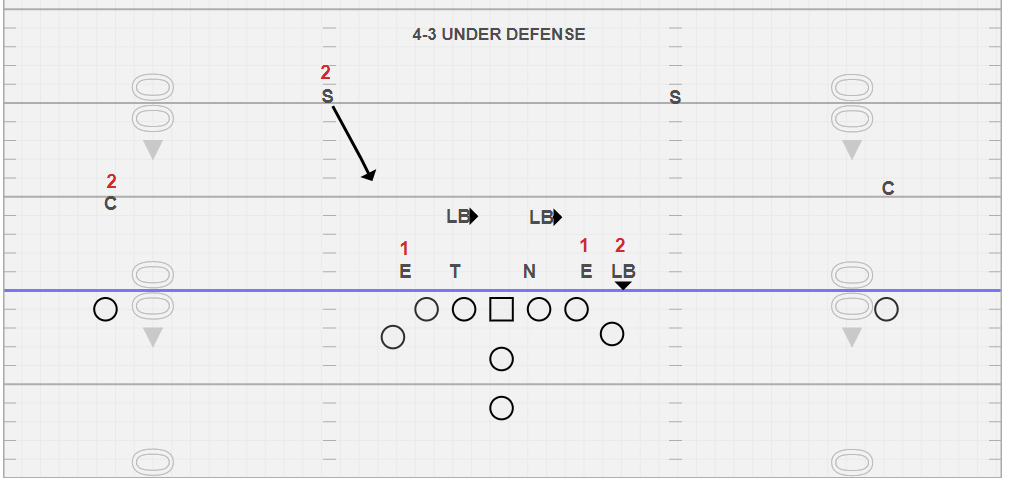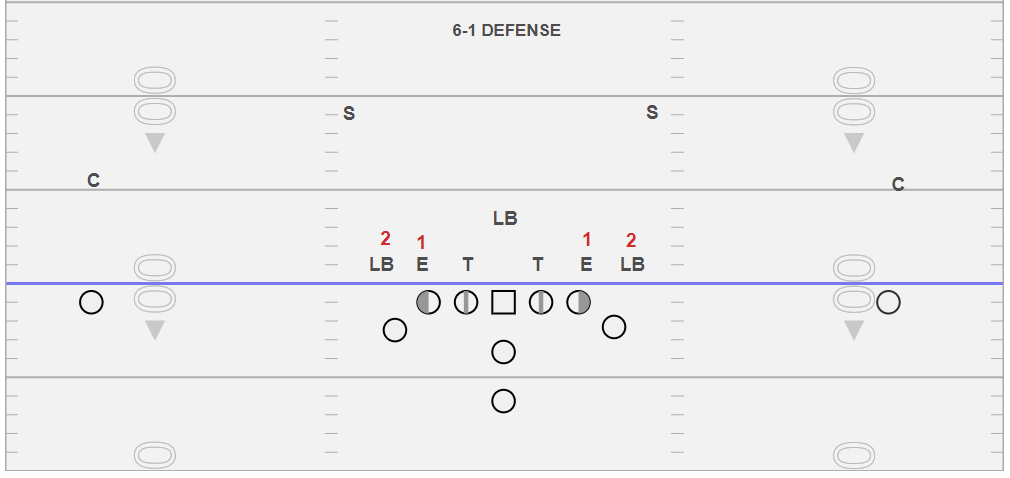Defensive Structures you Might Face as a New Option Coach
In this blog we will discuss the many even front defenses you may face as a new option coach. As we work through the different looks you may see, I want to remind you that these are labels that we use to identify different defenses. You may call them something different and that is ok. When we begin the discussion with our players about defenses we try to group the different looks into Even Fronts, Odd Fronts, and Junk. We also label who #1 and who #2 are in each scenario for the purposes of our base Inside Veer play. For the purpose of this article #1 is the hand off key (dive key) and #2 is the pitch key. We will begin with discussing a 4/4 or 4-2-5 defense.
Against this defense we identify the defender on or outside the PST as #1. The defender immediately outside of #1 is #2. Based on the image above, the defensive end is #1 and the outside linebacker is #2. We typically identify the force players in a defense as #2. A force player is defined as a defender who, by alignment, assignment and execution, cannot let the ball cross his face out get outside of him. We can manipulate those defenders by formation or by play tag to help us with a positive numbers advantage in option football.
The image above we define as a 4-3 defense. You will notice most defenses are named by their front alignment (number defensive lineman and linebackers). In this scenario we would label the defensive end as #1. #2 in this picture could promote some discussion. Some option coaches don’t like to read stacked #1 and #2 because you don’t know pre-snap who has dive and who has QB. In this scenario you would have to block the stacked linebacker and decide who #2 could be to read. Some option coaches allow their offensive lineman to make calls to alert if that stacked backer is “in” or “out” of the box. If he is considered in the box then the PST could outside release and block him. The center has to aid in that he must be able to block the Mike linebacker for this all to occur. The center has a call he can echo back to the tackle to confirm or vise versa. Lastly, based on the look above you could manipulate who #2 could be by using formations to declare a potential secondary player as #2.
We call the image above a 4-3 “hipped” defense. We refer to the “hipped” portion of the name to the linebackers that align on the defensive ends outside hip and a yard away. For us, we clearly define the defensive end as #1 and the “hipped” linebacker #2. We feel they have declared and unstacked pre-snap. This is not to say they can’t still play games with your reads. We feel the QB can see better, if #2 wraps inside of #1 out of this alignment. We also feel with #1 and #2 outside the PST we can take advantage of B gap with a couple of different option plays.
The next defense we have drawn is what we call Under. We teach the players that the linebackers have pulled the string and have shifted to our right and the defensive line has pulled the string and have shifted to our left. This is still an even 4-3 defense to us, even though you could consider #2 on the LOS thus making an odd front. We clearly define the defensive end #1 and the LB on the LOS to our right as #2. The other side of the defense is where being able to define #2 can get tricky. If we can determine the corner is below the hard deck (reference our previous article for what the hard deck is) then we would consider him #2, if the corner isn’t below the hard deck then we would assume the safety is rolling down behind the linebackers to be a force/cutback player and we would consider him #2.
This is the last even front defense we teach our players. This is what we call a 6-1 defense. We define both outside linebackers on the line of a scrimmage and in the box. The defensive end we define as #1 and the LB on LOS as #2. Most often we get the defensive lineman head up to inside the guards and tackles even though I don’t have it drawn that way exactly. We get a lot of “blood” stunts out of this look, which means that #1 spikes inside fast for the dive and #2 spikes inside fast for QB on the snap of the ball, looks like a blitz by both of them. We teach our QBs and A backs that if #2 is in a threatening position expect a pitch quickly and you will need to alter you pitch path so that you can be in the QB’s vision quickly. This is why, if you have read some previous posts, we have the A backs make loud “ball.ball..ball…” calls as they are looking at the QB while motioning. This gives confidence to the QB that he can hear you and see you and get the pitch delivered quickly and with confidence.
Our next blog post will continue with labeling Odd and Junk front defenses and as always feel free to discuss blog posts or ask questions on our forum page located here: http://flexbonenation.proboards.com/ If you have any questions please feel free to contact me on twitter @runthetriple or my email address lafayettefootball1@gmail.com.

